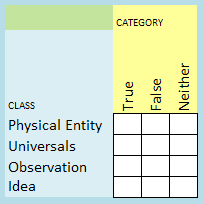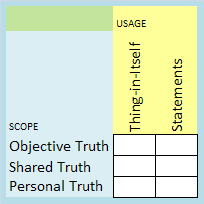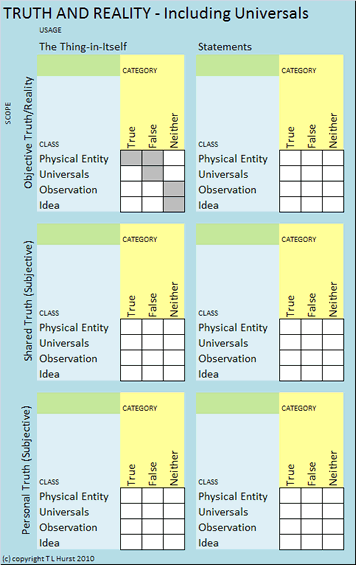This paper looks at the relationship between truth and reality, and identifies a number of terms that are relevant. The terms are grouped under four headings: Category, Scope, Class and Usage. Together, these factors form a four dimensional matrix, which is represented in a table by embedding an array of two of the factors in each cell of another array representing the other two factors.
This paper looks at the relationship between truth and reality. We examine what we mean by these terms, and we identify a number of other terms that are relevant...
As with all words, the word "true" means what you define it to. No more, no less. However, although superficially a simple concept, the truth can have many different meanings in different contexts. So this is an attempt to provide a comprehensive and consistent understanding of truth...
Observations, belief and ideas are thoughts, i.e. they exist in our minds:
A statement is the externalization of an observation, belief or idea. The truth of a statement can be quite separate from the truth of the idea it describes. Thus I may say "I believe that the moon is made of green cheese". Whether this statement is true or not does not depend on whether the moon is actually made of green cheese. It only depends upon whether I believe this to be so. As such it is a statement of belief.
Whereas the statement "The moon is made of green cheese" is only true if:
The first is an example of an absolute (or literal) truth. The second is an example of relative (or metaphorical) truth. Hence this is a statement of fact (which may, or may not, be true).
A statement may be partially true. If so, it may be broken down into true and false parts.
It may be claimed that, objectively, statements are either true or false, i.e. they cannot be neither true nor false. This idea rests on the view that the truth value of a statement is atemporal. However, there is a contrary view that the future is not determinate. In which case, the truth value of statements about future events would be indeterminate until the events occurred.
By this definition, truth is a general term that has illusory, personal, shared, subjective and objective aspects. It also encompasses observations, beliefs and ideas as things-in-themselves, and statements about them. All are aspects of truth and its relationship to reality.
We may summarize the meaning of truth as:
Entities can be categorized as being "real" or "imaginary":
Real entities continue to exist whether we are cognizant of them ar not, and can be subdivided into:
Imaginary entities exist within our perception and can be subdivided into:
The term "exist" encompasses entities that are real and imaginary.
Note: We do not speculate on the form in which real entities exist, nor do we need to. It is sufficient for these purposes that such entities continue to exist, in whatever form they do exist, whether we are cognizant of them or not.
"Universals" are abstract entities that are thought to be real, i.e. they exist whether we are aware of them or not. These include numbers and their relationships. "Realists" maintain that universals are real. "Nominalists" maintain that they are not.
It seems to me that at least some universals are neither real nor universal. This is because we have universals for things that are not, and never have been, real. Like fairies, gnomes, goblins and unicorns. Since these creatures exist only in stories and our imaginations, it seems logical that their universals are equally imaginary. If so, it follows that they only exist in the minds of those people who have heard of them. So they are cultural rather than universal.
Furthermore, if some universals are imaginary and cultural, then there is no necessity for any universals to be real and universal. They could all be imaginary and cultural. This does not prove that they are not real, but it does question why we should assume that any universals are real? One reason is that with universals such as numbers, there seems to be a genuine universality. Numbers and their relationships are the same irrespective of what they are called, and irrespective of whether we are aware of them. However, is this universality inherent in numbers themselves, or in the behaviour of physical reality?
For example, if science were to show that in some extreme circumstance the universe did not obey the universality of numbers, then numbers would no longer be universal. Hence their universality is dependent upon the behaviour of the universe, not the other way round. So I conclude that these universals could be concepts describing the universality (as far as we know) of the behaviour of physical reality.
Hence, it is arguable that universals are just another type of ideas. However, for completeness, we include universals as a class of entity, with the proviso that they may or may not be real.
An obvious place to start when analyzing the relationships between truth and reality is with statements. Statements may be true or false, depending upon whether they correlate to reality. Alternatively, the truth value of statements about future events may be indeterminate.
However, before we can make a statement we have to conceptualize the entities. Concepts may describe things that are real, in the sense that they exist whether we are cognisant of them or not, and those that exist entirely within our cognition:
However, statements are not the only things that may be true or false. Observations and ideas may be true in themselves, in addition to statements about them.
Then there is the scope within which an entity may be true. It may be:
Note: A shared truth is distinguished from a personal truth because a shared truth may be considered as "knowledge", whereas it is difficult to see that a personal truth, without any corroboration, qualifies as such.
The factors defining truth may be formalized into four dimensions. These are:
* The truth value of statements about future events may be indeterminate if the events themselves are not determinate.


A representation of truth as a four dimensional array is inherently dificult to visualize, but we can represent it in two parts by mapping the Usage against the Scope, and the Category against the Class.
A table representing the full array can then be produced by embedding the Category against Class array in each cell of the Usage against Scope array. Each copy of the category and class array is in a different context of usage and scope. Therefore each occupies a unique position in the overall table.

Some cells in the upper row of category and class arrays are shaded, as they are invalid:
Some groupings form sub-groups: